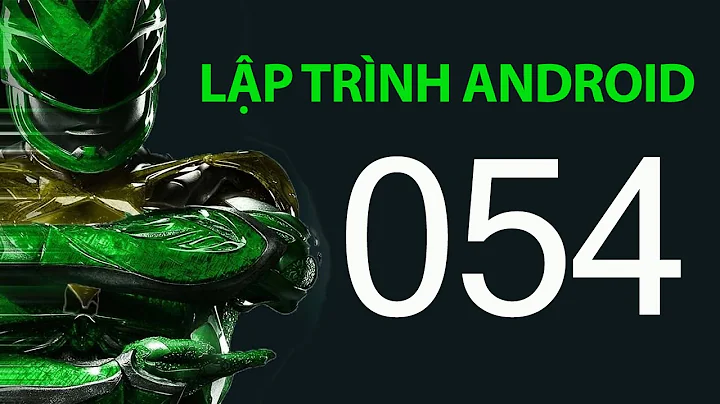What is the difference between Bitmap and Drawable in Android?
Solution 1
A Bitmap is a representation of a bitmap image (something like java.awt.Image). A Drawable is an abstraction of "something that can be drawn". It could be a Bitmap (wrapped up as a BitmapDrawable), but it could also be a solid color, a collection of other Drawable objects, or any number of other structures.
Most of the Android UI framework likes to work with Drawable objects, not Bitmap objects. A View can accept any Drawable as a background. An ImageView can display a foreground Drawable. Images stored as resources are loaded as Drawable objects.
Solution 2
Bitmap is not an image. Bitmap is a map of bit (note name: Bit-map). And this map represents pixels on which you can draw something. It may be your own custom bitmap (not image), for example square:
Bitmap bitmap = Bitmap.createBitmap(100, 100, Bitmap.Config.ARGB_8888);
or you can create Bitmap object from image:
Bitmap bitmap = BitmapFactory.decodeResource(getResources(), R.drawable.your_image);
A Bitmap is a pixels holder. And Canvas is used to draw something on your bitmap (on Bitmap pixels).
Everything about Drawable is well described above.
TL;DR
Some people write that you draw on Canvas. You don't draw on Canvas. You draw on Bitmap pixels with Canvas helper method.
Bitmap bitmap = Bitmap.createBitmap(100, 100, Bitmap.Config.ARGB_8888);
Canvas canvas = new Canvas(bitmap);
canvas.drawColor(Color.RED) // now all bitmap pixels became red
Solution 3
Drawable is something which can be drawn. E.g. layout, vector image (line, circle), font, image and so on
Bitmap - is specific type of Drawable which is image, like: PNG, JPEG or so
Solution 4
Drawable Resource
A Drawable resource is a general concept for a graphic that can be drawn to the screen and which you can retrieve with APIs such as getDrawable(int) or apply to another XML resource with attributes such as android:drawable and android:icon. There are several different types of drawables:
Bitmap File, A Bitmap graphic file, (.png, .jpg, or .gif), creates a
BitmapDrawable.Nine-Patch File, A
PNGfile with stretchable regions to allow image resizing based on content (.9.png), creates aNinePatchDrawable.Layer List, A
Drawablethat manages an array of otherDrawables. These are drawn in array order, so the element with the largest index is drawn on top, creates aLayerDrawable.State List, An
XMLfile that references different bitmap graphics for different states (for example, to use a different image when a button is pressed), creates aStateListDrawable.Level List, An
XMLfile that defines aDrawablethat manages a number of alternateDrawables, each assigned a maximum numerical value, creates aLevelListDrawable.Transition Drawable, An
XMLfile that defines aDrawablethat can cross-fade between twoDrawableresources, creates aTransitionDrawable.Inset Drawable, An
XMLfile that defines aDrawablethat insets anotherDrawableby a specified distance. This is useful when aViewneeds a backgroundDrawblethat is smaller than the View's actual bounds.Clip Drawable, An
XMLfile that defines aDrawablethat clips anotherDrawablebased on thisDrawable's current level value, creates aClipDrawable.Scale Drawable, An
XMLfile that defines aDrawablethat changes the size of anotherDrawablebased on its current level value, creates aScaleDrawable.Shape Drawable, An
XMLfile that defines a geometric shape, including colors and gradients, creates aShapeDrawable.
Also see the Animation Resource document for how to create an AnimationDrawable.
Note: A color resource can also be used as a Ddrawable in XML. For example, when creating a StateListDrawable, you can reference a color resource for the android:drawable attribute (android:drawable="@color/green").
Bitmap
A bitmap image. Android supports bitmap files in three formats: .png (preferred), .jpg (acceptable), .gif (discouraged).
You can reference a bitmap file directly, using the filename as the resource ID, or create an alias resource ID in XML.
Note: Bitmap files may be automatically optimized with lossless image compression by the aapt tool during the build process. For example, a true-color PNG that does not require more than 256 colors may be converted to an 8-bit PNG with a color palette. This will result in an image of equal quality but which requires less memory. So be aware that the image binaries placed in this directory can change during the build. If you plan on reading an image as a bit stream in order to convert it to a bitmap, put your images in the res/raw/ folder instead, where they will not be optimized.
Related videos on Youtube
Nikhil C George
Updated on July 15, 2022Comments
-
Nikhil C George almost 2 years
I googled but i couldn't find any article to describe about the difference between Bitmap and Drawable in Android.
-
Jrom over 12 yearsThis solution should be able to answer your questions: solution
-
-
 Ted Hopp over 12 years
Ted Hopp over 12 years -
Barmaley over 12 yearsSure, it's my fault. I meant BitmapDrawable
-
 android developer almost 12 yearsif a bitmapDrawable wraps a bitmap , what would occur if we call recycle() on the bitmap within it ? also , what does recycle() do for API11 and above?
android developer almost 12 yearsif a bitmapDrawable wraps a bitmap , what would occur if we call recycle() on the bitmap within it ? also , what does recycle() do for API11 and above? -
 Ted Hopp almost 12 years@androiddeveloper - I'm not sure, but it won't be anything good. Once a bitmap is wrapped by a BitmapDrawable, the drawable "owns" the bitmap and is supposed to manage its life. If you call
Ted Hopp almost 12 years@androiddeveloper - I'm not sure, but it won't be anything good. Once a bitmap is wrapped by a BitmapDrawable, the drawable "owns" the bitmap and is supposed to manage its life. If you callrecycle(), you are interfering with that relationship. At best, the drawable will draw nothing; more likely, some sort of exception will be thrown later on. According to the docs,recycle()with API11+ does the same thing it always did: it allows you to free the native pixels as soon as you know you are done with them. -
 android developer almost 12 yearsthey say there that it frees the native memory of the bitmap , but we know that as of API 11 , everything related to the bitmap (including its raw data) is inside the heap , so recycle seems like a weird thing to do ...
android developer almost 12 yearsthey say there that it frees the native memory of the bitmap , but we know that as of API 11 , everything related to the bitmap (including its raw data) is inside the heap , so recycle seems like a weird thing to do ... -
 Ted Hopp almost 12 years@androiddeveloper - Looking at the source, it seems that there's still a native bitmap. For performance purposes, the raw buffer is exposed as a public member (although still hidden from the public API). Calling
Ted Hopp almost 12 years@androiddeveloper - Looking at the source, it seems that there's still a native bitmap. For performance purposes, the raw buffer is exposed as a public member (although still hidden from the public API). Callingrecycle()will still free the native bitmap; it will also set the member buffer tonull. -
 android developer almost 12 yearsyes, i've read it too , but it doesn't make sense, since they said on google IO that the bitmap is no longer stored in the native memory . i'm really confused of how could it be.
android developer almost 12 yearsyes, i've read it too , but it doesn't make sense, since they said on google IO that the bitmap is no longer stored in the native memory . i'm really confused of how could it be. -
 HarshitMadhav almost 6 yearsNice answer deserves +1 :) Thanks for the explaining by lines of code.
HarshitMadhav almost 6 yearsNice answer deserves +1 :) Thanks for the explaining by lines of code. -
mallaudin over 5 yearsBut they say Bitmap: the simplest Drawable, a PNG or JPEG image. in docs.
-
mallaudin over 5 yearsI thought I pasted from this link. developer.android.com/guide/topics/resources/…
-
 Tushar Srivastava over 5 yearsperfectly explained
Tushar Srivastava over 5 yearsperfectly explained






